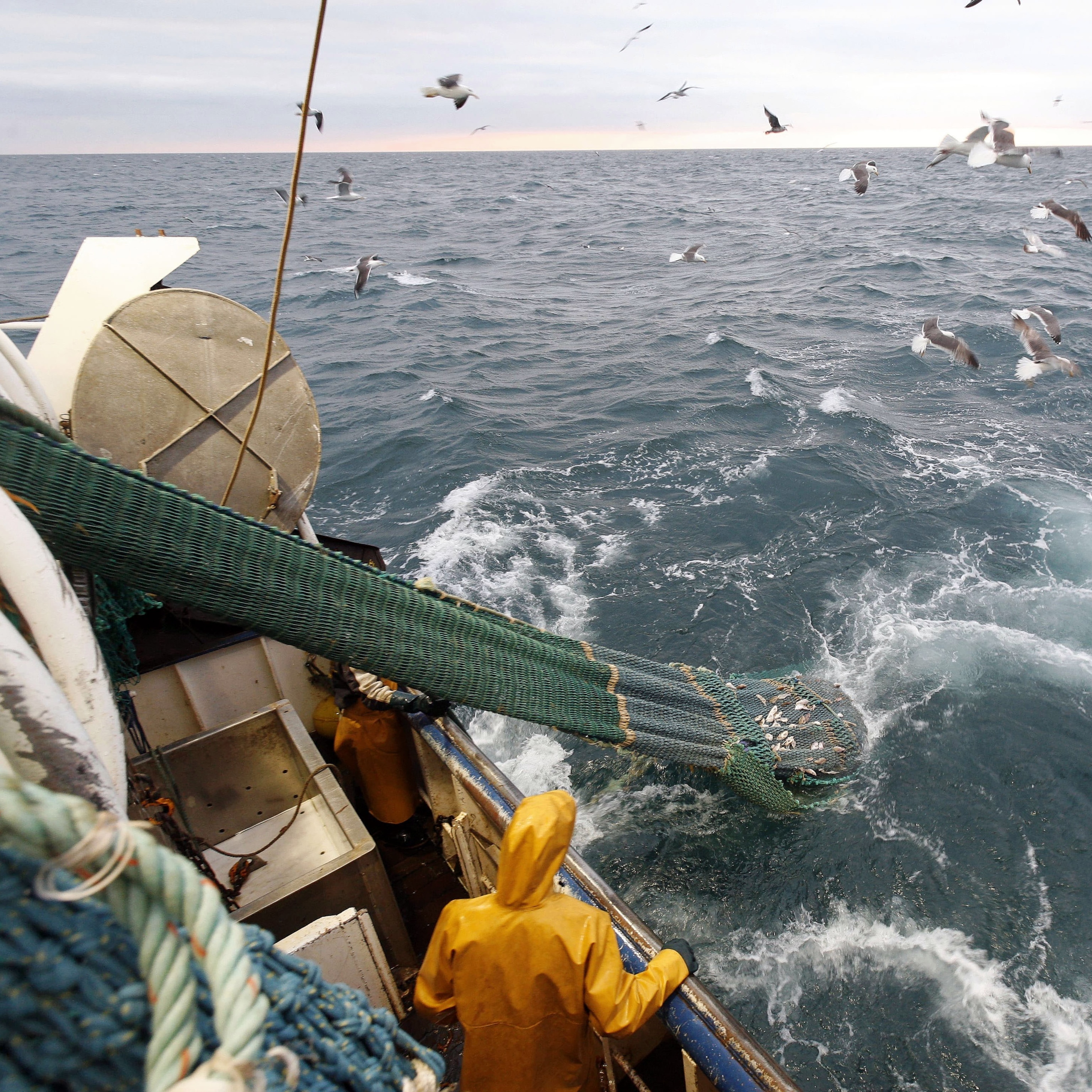
See the vibrant ice fishing culture under threat in the Great Lakes
For anglers across the northern reaches of the U.S., winter is "what we've been waiting for."
The icy Michigan morning was pitch black when photographer Amy Sacka climbed onto the back of a snowmobile at 5 a.m. She was bundled in layers of fleece and Gore-Tex, wrapped so thoroughly that only her eyes were exposed. In the frigid darkness, the snowmobile’s engine shuddered on and charged across the frozen expanse of Lake Michigan.








Her guides, Jordan Millette and Bryant Dault, were expert ice anglers. As they took off across the ice, they navigated by the dim light of a GPS screen toward a frozen Valhalla: A prime fishing spot, miles out across the frozen lake. Here they would post up for the day, drill an eight-inch-wide hole through the thick slab of ice, set their tip-ups, and wait patiently for the big one to bite.
Ice fishing is a beloved pastime, a multi-million- dollar business, and cultural identifier for communities across the northern U.S. In any given year, more than 1.5 million people go out on the ice, and thousands of families gather around a meal of fish pulled out of icy water only hours earlier. But as winters warm, ice culture has to reckon with something trickier to navigate than choosing the right lure or picking the best spot on the ice: a changing climate that may endanger the experience of winter itself.
Sacka, the photographer, was along for the ride. She was there to learn about, experience, and document the vibrant ice fishing culture that emerges during the icy Northern winters. During the 2017 to 2018 winter season, she drove 10,000 miles around the edges of the Great Lakes, photographing anglers along with the culture and natural beauty that surround them.
Ice culture is strong
Winter is a time for celebration across the upper Midwest.
“If you’re a fisherman, or an outdoorsy person, the winter—well, that’s what we look forward to,” says Linda Bennett, a former professional angler and avid ice fishing enthusiast from Michigan.
She spends entire days out on the ice. Sometimes she fishes on small local lakes. Other times she opts for the “big water” of Lake Erie or Canada's Lake Simcoe. She’s up before dawn, bundling into a pile of clothes, strapping crampons to the bottoms of her hefty boots, and heading out on the ice first thing in the morning, casting lines down into the dark waters below.
“It’s really a way of life for us,” she says. “January, February, March—that’s when I get excited.”



The warming lakes
A cold snap has engulfed the Midwest over the past week, plunging the region into record-breaking cold. Despite this stretch of cold weather, there is a clear pattern: Over the long term, winters around the world are warming faster than other seasons. (Read about how cold weather doesn’t mean the planet isn’t still getting toastier).
In the upper Midwest, the trend is particularly marked. Average winter air temperatures in Ann Arbor, Michigan have increased by nearly one degree Fahrenheit since 1951. Further north, in Minnesota, the averages in the past 40 years have been up to three degrees warmer than they were in the 19th century.



In tandem, the ice season in the Great Lakes region has shortened by about two weeks over the past few decades. Ice freezes in a few days later than it used to and melts away sooner in the spring. All in all, ice coverage on the Great Lakes—that is, the portion of the lakes’ surface that freezes annually—has fallen by a whopping 71 percent since 1974.
At Lake Mendota, in southern Wisconsin, the ice season used to start in early December. Now, the ice is rarely in place before Christmas. This year, it only set in a few weeks ago, in mid-January. Overall, the ice season at the lake has shortened from about four months long, in the middle of the 19th century, to only about three months long today.
“The lakes are so sensitive to climate,” says John Magnuson, a researcher at the University of Wisconsin, Madison, who has studied lakes in the region for decades. “Already people notice that ice is getting shorter, and there’s an impact on winter recreation—the skating, the ice fishing.”
Community in the cold
The long-term patterns are clear, and the outlook for anglers is not good. By the time some of the children going out for their first fishing experiences this winter grow up, the kind of thick, safe ice they feel under their crampons today may be an elusive relic of winters past.
Still, any given year could end up cold and icy because of the complicated ways weather patterns shift. For example, in the northern reaches of Michigan, Jordan Millette, an ice fishing guide, says the ice locked up early this year, opening up a plethora of fishing opportunities in lakes that haven’t iced over in recent years.
Magnuson, too, points out that communities come together around frozen lakes. “When a lake freezes and becomes safe, all of sudden it’s available to everyone in town,” he says. “You don’t have a have a boat, a canoe, or property on a lake—you just get to the shores, park anywhere, and walk on out to the ice. Everyone, everyone can enjoy the lakes then.”

Related Topics
You May Also Like
Go Further
Animals
- This ‘saber-toothed’ salmon wasn’t quite what we thoughtThis ‘saber-toothed’ salmon wasn’t quite what we thought
- Why this rhino-zebra friendship makes perfect senseWhy this rhino-zebra friendship makes perfect sense
- When did bioluminescence evolve? It’s older than we thought.When did bioluminescence evolve? It’s older than we thought.
- Soy, skim … spider. Are any of these technically milk?Soy, skim … spider. Are any of these technically milk?
- This pristine piece of the Amazon shows nature’s resilienceThis pristine piece of the Amazon shows nature’s resilience
Environment
- This pristine piece of the Amazon shows nature’s resilienceThis pristine piece of the Amazon shows nature’s resilience
- Listen to 30 years of climate change transformed into haunting musicListen to 30 years of climate change transformed into haunting music
- This ancient society tried to stop El Niño—with child sacrificeThis ancient society tried to stop El Niño—with child sacrifice
- U.S. plans to clean its drinking water. What does that mean?U.S. plans to clean its drinking water. What does that mean?
History & Culture
- Meet the original members of the tortured poets departmentMeet the original members of the tortured poets department
- Séances at the White House? Why these first ladies turned to the occultSéances at the White House? Why these first ladies turned to the occult
- Gambling is everywhere now. When is that a problem?Gambling is everywhere now. When is that a problem?
- Beauty is pain—at least it was in 17th-century SpainBeauty is pain—at least it was in 17th-century Spain
Science
- Here's how astronomers found one of the rarest phenomenons in spaceHere's how astronomers found one of the rarest phenomenons in space
- Not an extrovert or introvert? There’s a word for that.Not an extrovert or introvert? There’s a word for that.
- NASA has a plan to clean up space junk—but is going green enough?NASA has a plan to clean up space junk—but is going green enough?
- Soy, skim … spider. Are any of these technically milk?Soy, skim … spider. Are any of these technically milk?
Travel
- Could Mexico's Chepe Express be the ultimate slow rail adventure?Could Mexico's Chepe Express be the ultimate slow rail adventure?
- What it's like to hike the Camino del Mayab in MexicoWhat it's like to hike the Camino del Mayab in Mexico







